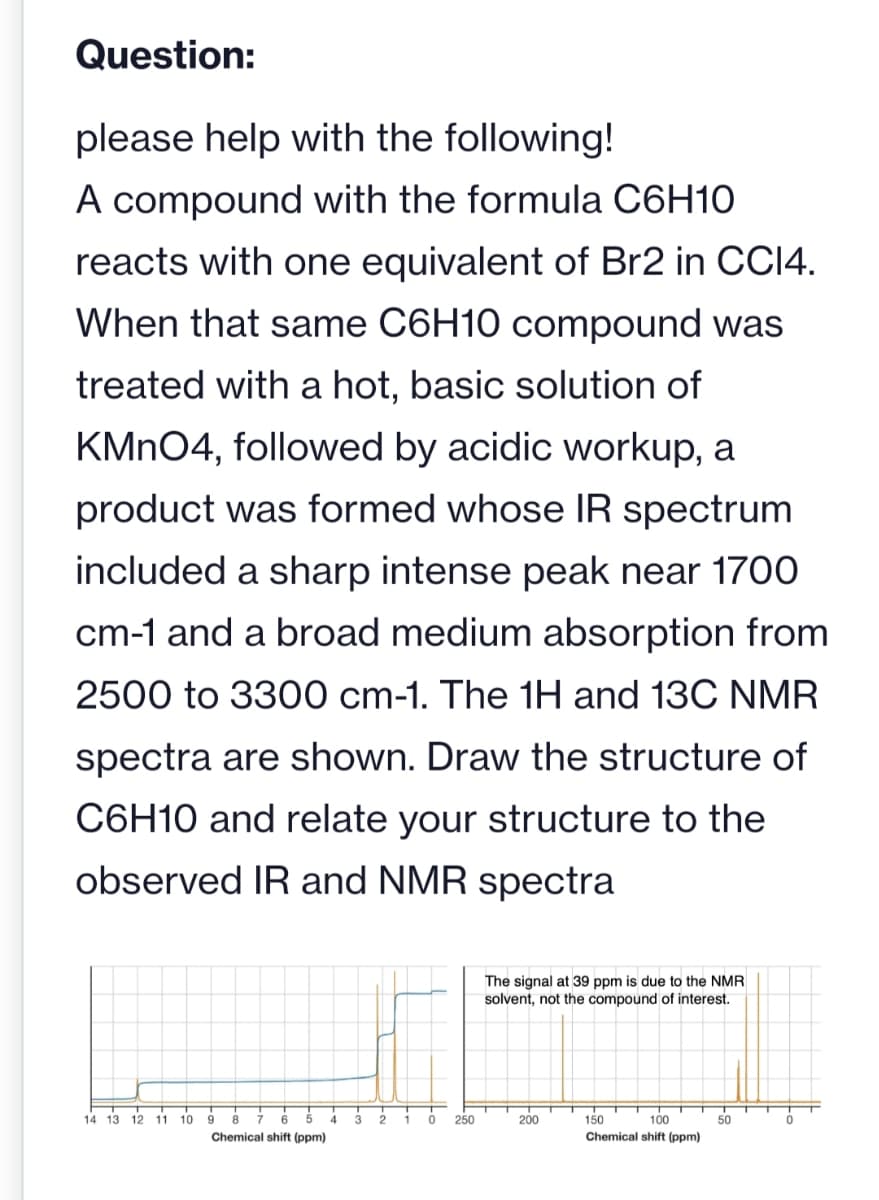please help with the following! A compound with the formula C6H10 reacts with one equivalent of Br2 in CC14. When that same C6H10 compound was treated with a hot, basic solution of KMnO4, followed by acidic workup, a product was formed whose IR spectrum included a sharp intense peak near 1700 cm-1 and a broad medium absorption from 2500 to 3300 cm-1. The 1H and 13C NMR spectra are shown. Draw the structure of C6H10 and relate your structure to the observed IR and NMR spectra 14 13 12 11 10 6 9 8 Chemical shift (ppm) 4 3 ₂ 1 0 250 The signal at 39 ppm is due to the NMR solvent, not the compound of interest. 200 150 100 Chemical shift (ppm) 50 0
please help with the following! A compound with the formula C6H10 reacts with one equivalent of Br2 in CC14. When that same C6H10 compound was treated with a hot, basic solution of KMnO4, followed by acidic workup, a product was formed whose IR spectrum included a sharp intense peak near 1700 cm-1 and a broad medium absorption from 2500 to 3300 cm-1. The 1H and 13C NMR spectra are shown. Draw the structure of C6H10 and relate your structure to the observed IR and NMR spectra 14 13 12 11 10 6 9 8 Chemical shift (ppm) 4 3 ₂ 1 0 250 The signal at 39 ppm is due to the NMR solvent, not the compound of interest. 200 150 100 Chemical shift (ppm) 50 0
Macroscale and Microscale Organic Experiments
7th Edition
ISBN:9781305577190
Author:Kenneth L. Williamson, Katherine M. Masters
Publisher:Kenneth L. Williamson, Katherine M. Masters
Chapter13: Mass Spectrometry
Section: Chapter Questions
Problem 3Q
Related questions
Question
Please send me the question in 20 minutes it's very urgent plz find

Transcribed Image Text:Question:
please help with the following!
A compound with the formula C6H10
reacts with one equivalent of Br2 in CCI4.
When that same C6H10 compound was
treated with a hot, basic solution of
KMnO4, followed by acidic workup, a
product was formed whose IR spectrum
included a sharp intense peak near 1700
cm-1 and a broad medium absorption from
2500 to 3300 cm-1. The 1H and 13C NMR
spectra are shown. Draw the structure of
C6H10 and relate your structure to the
observed IR and NMR spectra
14 13 12 11 10
9 8
Chemical shift (ppm)
A
3 2
0
250
The signal at 39 ppm is due to the NMR
solvent, not the compound of interest.
200
T
150
100
Chemical shift (ppm)
50
T
0
Expert Solution
This question has been solved!
Explore an expertly crafted, step-by-step solution for a thorough understanding of key concepts.
Step by step
Solved in 3 steps with 3 images

Knowledge Booster
Learn more about
Need a deep-dive on the concept behind this application? Look no further. Learn more about this topic, chemistry and related others by exploring similar questions and additional content below.Recommended textbooks for you

Macroscale and Microscale Organic Experiments
Chemistry
ISBN:
9781305577190
Author:
Kenneth L. Williamson, Katherine M. Masters
Publisher:
Brooks Cole

Macroscale and Microscale Organic Experiments
Chemistry
ISBN:
9781305577190
Author:
Kenneth L. Williamson, Katherine M. Masters
Publisher:
Brooks Cole